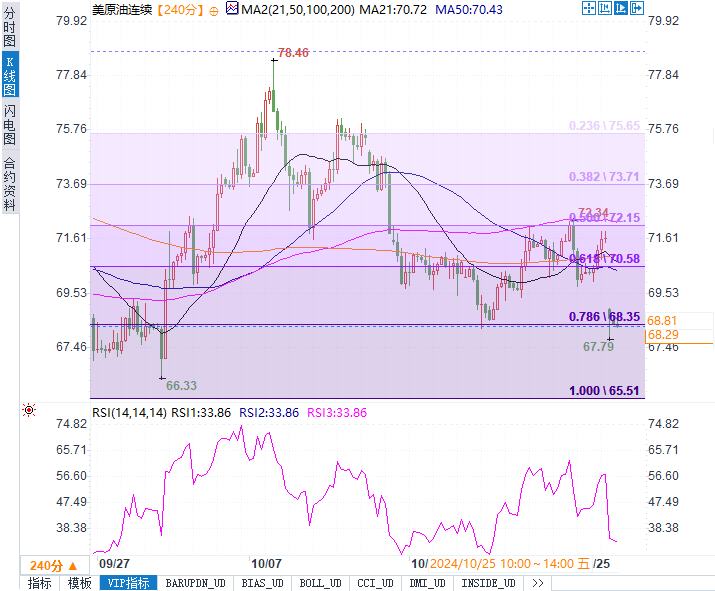Oil prices have plummeted by over 4%! Can crude oil continue to hold on despite the easing of geopolitical tensions?
On Monday (October 28th), the crude oil market was once again affected by the situation in the Middle East, but prices unexpectedly fell. Brent crude oil and WTI crude oil futures both fell more than $3 per barrel in early trading, recording declines of 4.4% and 4.79%, respectively. At 16:15 Beijing time, Brent crude oil futures were reported at $72.62 per barrel, while WTI was reported at $68.35 per barrel. This is the lowest level for both since October 1st. The main influencing factor comes from Israel's military actions against Iran not touching oil facilities, thereby weakening the market's expected risk premium.
Market dynamics: Geopolitical premium weakened
Over the weekend, Israel's multiple airstrikes on Iran did not affect Iran's oil infrastructure and did not further exacerbate the tense energy supply situation in the region. Iranian officials have stated that the strike has caused limited losses and has not affected oil and gas related facilities, which has raised market expectations for a easing of the situation. MST Marquee's energy analyst Saul Kavonic pointed out that the "low intensity and limited targets" of the current attacks have caused the risk premium to disappear by several dollars.
At present, the key focus of the market is whether Iran will continue to choose restraint, which will determine whether the risk premium of oil prices will rise again in the coming weeks. Australian Federal Bank analyst Vivek Dhar pointed out that the market's focus may shift towards ceasefire negotiations between Israel and Hamas. Although Israel maintained a low level of aggression in this operation, there is still significant uncertainty regarding the response of proxy armed groups (Hamas and Hezbollah).
Fundamentals and Price Trends
According to CBA analysts' predictions, the tense relationship between Israel and Iran may temporarily ease, and the market's premium expectations for future conflicts are gradually decreasing. As a result, the Max Layton team of analysts at Citibank has lowered their target price for Brent crude oil for the next three months from $74 to $70, reflecting the pressure on overall oil prices from the fading risk premium.
Today, Brent crude oil futures opened with a significant bearish gap, falling below $73.90 and approaching analysts' expected target of $72.06. Random indicators also release negative signals, indicating further downward pressure. If the price falls below the support level of $72.06, Brent crude oil may further move towards the $70.90 area. It should be noted that once the price rebounds and breaks through $73.90, the current bearish trend may stop, and the initial rebound target level will point to $75.36. Today's trading range is expected to fluctuate between $71.00 and $74.00.

In terms of WTI, the opening price also formed a bearish gap, hitting the target level of $68.65. If it continues to decline, the next bearish target is $67.00. Analysts pointed out that WTI still maintains a bearish market scenario during the day, and the current trading range is expected to be between $67.10 and $70.10, influenced by the previously formed double top pattern.

OPEC+stance and future supply-demand balance
The OPEC+meeting in October maintained the current oil production policy, including plans to increase production from December onwards. Subsequent policies will depend on the resolution of the meeting on December 1st. Given the decline in risk premium, market participants generally believe that OPEC+may postpone its production increase plan in order to support current oil prices. Tim Evans, an analyst at Evans Energy, stated in a report that "the recent decline in oil prices has led to a certain degree of underestimation in the market, and it is expected that OPEC+will consider increasing production after December
Short term outlook
Based on the current market situation, the risk premium caused by the tense situation in the Middle East is expected to weaken in the short term, and oil prices may continue to face downward pressure, testing the support level below. Brent crude oil needs to pay attention to the stability of the support at $72.06. Once it falls below, it will develop towards the $70.90 area in the short term. Similarly, if WTI effectively falls below the support level of $68.65, it may approach its target of $67.00.
However, the situation in the Middle East remains highly uncertain, and investors need to closely monitor the latest developments between Israeli and Iranian proxies. If the situation escalates again, it cannot be ruled out that the risk premium of oil prices may rise again.
Overall, the support of geopolitical tensions for oil prices is gradually weakening, but the market has not completely eliminated the unease. The supply and demand policy trends of OPEC+will provide another important clue for future oil prices. If OPEC+delays production increase, it may support the stabilization of oil prices.
Tips:This page came from Internet, which is not standing for FXCUE opinions of this website.
Statement:Contact us if the content violates the law or your rights
